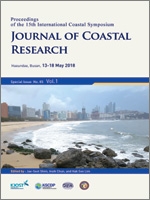Mascarenhas, A.C.C.; Correa, A.W.R.; Carneiro, A.C.; Costa, M.S.; Rollnic, M., and Medeiros, C., 2018. Seasonal Exchanges of Salt and Suspended Particulates between the Sol Bay and the Pará River, Amazonian Coast. In: Shim, J.-S.; Chun, I., and Lim, H.S. (eds.), Proceedings from the International Coastal Symposium (ICS) 2018 (Busan, Republic of Korea). Journal of Coastal Research, Special Issue No. 85, pp. 111–115. Coconut Creek (Florida), ISSN 0749-0208.
Salt and suspended particulate matter (SPM) exchange between the Sol Bay and the Pará River and their tidal/seasonal variability was investigated along the interface cross-section (1°4′30.37″S 48°19′37.48″W), over spring tidal cycles, during the wet (Apr/2015) and dry (Oct/2015) seasons. Advective transport of salt and SPM was analyzed to evaluate trends and contributions of involved mechanism. Overall, salinity was low (S<2) during dry and absent during the wet season. Mean SPM concentrations where higher at flood tides during both seasons. Higher flow velocities were 1.29 m.s−1 (ebb/wet) and 1.17 m.s−1 (flood/dry). During the dry season net salt transport was 8.10 kg.s−1 seawards mainly due to a baywards Stokes drift transport (−193.7 kg.s−1) against a seawards transport by the river discharge, tidal correlation and turbulent shear components ( 179.0; 11.98; 7.72 kg.s−1). However, SPM was stored into Sol Bay at a rate of 2.06 kg.s−1 (90 ton per tidal cycle), as result of the baywards transport by the Stokes drift river discharge (−3.14; −0.82 kg.s−1) in opposition to the seawards transport due to gravitational circulation tidal correlation components ( 1.69; 0.48 kg.s−1). During the wet season the river discharge (29.8 kg.s−1) fluxes out SPM from Sol Bay while the Stokes drift (3.19 kg.s−1) and the turbulent shear (0.65 kg.s−1) components tends to move SPM back into the bay with a net exportation of SPM to the Pará River of 26 kg.s−1 (129.8 ton per tidal cycle). In conclusion, matter exchange between the Sol Bay and the Pará River is mainly governed by the river discharge and Stokes drift flow components. The relative contributions by the gravitation circulation, tidal correlation and turbulent shear tend to increase under low river discharge. A small salt exportation ( 8.10 kg.s−1) during the dry season





